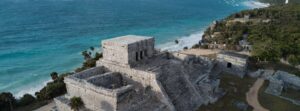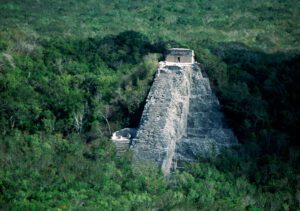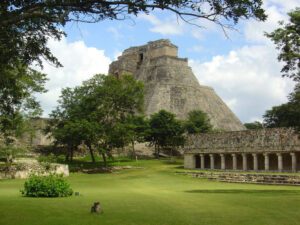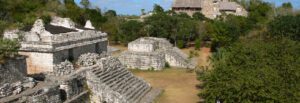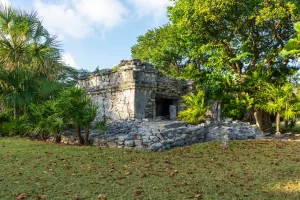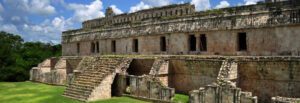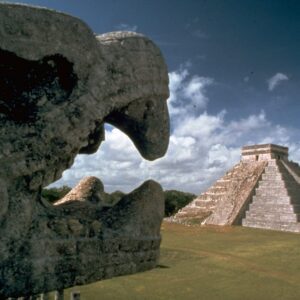THE MAYAN LEGACY
If traveling to southeast Mexico is next on your bucket list, Mayan Archeological Ruins should probably be on the first stops, next to the beach and food tours, obviously.
Archeological sacred temples, now in ruins, are scattered all throughout Mexico, from the Caribbean shore to the Gulf of Mexico. Vestiges of Mayan cities built by their late ancestors and stone pyramids, abandoned for mysterious reasons and left to be overtaken by the jungle.
Many Mayan ruins have been excavated and opened to the public. Although some stand out more than others, all of them still have a lot to tell. And to help them deliver their secret messages to you, my dear history-hungry foodies, I bring to you my own Top 8 Mayan Ruins, they’re not necessarily numbered from “best” to “not-so-best”, that’s for you to decide:
CHICHÉN ITZÁ
Source: mexicodesconocido.com.mx
No, it’s not “Chicken Pizza.” Chichen Itzá. Located in a nice little Colonial town near Valladolid, Yucatan. World Heritage Site and recognized as one of the Seven Wonders of the Modern World. City and ceremonial center, which went through various construction periods and influences from different civilizations that occupied it since its foundation.
The God who presides over the site, according to Mayan mythology, is Kukulkán, a Mayan representation of Quetzalcóatl, a god taken from the pantheon of the Toltec culture.
The Chichén Itzá archaeological zone is world-famous for the interesting phenomenon of light and shadow which takes place during each equinox on the stairs of the Pyramid of Kukulkán. A solar projection of triangles creates the appearance of the emblematic feathered serpent that gradually descends one of the stairs until it reaches the serpent head, located in the lower part of the pyramid. The process from its start to finish lasts approximately 45 minutes.
This event, achieved from the correct orientation and inclination of the planes of the pyramid platforms, shows the great level of astronomical and architectural knowledge that the Mayas possessed.
Chichen Itza opens every day from Monday to Sunday from 8 a.m to 5 p.m.
TULUM
Source: caribemexicano.travel
Located in Zama, the Mayan City of Dawn, best known as Tulum. Our ancestors had the brilliant idea of building this great walled city with the best views of the Caribbean.
Zamá had access to both land and sea trade routes, making it an important trade hub. It also appears to have been an important site for the worship of the Descending serpent-god Kukulkán.
The archaeological site of Tulum has more than 60 restored temples, El Castillo is the main building, being the most photographed one due to its peculiar location on the cliff.
The Mayan city is surrounded by walls, each symbolizing one of the elements: earth, water, air, and fire. The Mayans made structures in the form of quadrilaterals reflecting their vision of the universe and spirituality.
After learning a bit of Mayan history, take down the stairs to the beach and take a good swim to glance at the Tulum ruins from the Caribbean sea.
The Archaeological site of Tulum is located in the middle of the Riviera Maya. Between the entrance and the actual ruins, there is a track of about 1 km. You can either walk, rent a bicycle or take a little train that takes you for $20 mxn.
Open from Monday to Sunday from 8 a.m. to 5 p.m.
COBÁ
Source: pueblosmexico.com.mx
Some hieroglyphic inscriptions found on stelae and panels at the site allow us to affirm that Cobá was the original name of the city.
The city of Cobá was close to five lakes that were a fundamental factor for its development and subsistence. The almost 70km2 city was connected by large lime-stone roads that glow in the full-moon light, known in the Mayan language as sacbé (white roads), which in ancient times connected the Mayan kingdoms. The longest of them, with 100 km, reaches the site of Yaxuná, very close to Chichén Itzá. The construction boom of the city occurred between 800 and 1000 AD, when the network of roads was expanded, new structures were built and its relations with the Gulf Coast were strengthened.
Only 10% of Cobá ruins have been discovered, while the other 90% of buildings are buried or covered by the jungle. (Mindblowing)
It is located 2 and a half hours from Cancun, 1 hour 30 minutes from the Riviera Maya, and only 40 minutes from Tulum. (This also depends on how fast is the driver haha). There are several means of transportation that can take you, although sometimes it is better to hire a tour with a guide who will explain a bit of history and curious facts.
Open every day from 8 a.m to 4 p.m.
UXMAL
Source:playasmexico.com.mx
The name of this pre-Hispanic capital comes from “Oxmal” which means “built three times”, referring to the antiquity of the city and the variety of cultures that influenced its style and construction. It is also possible that the word ux (“to harvest”, in Maya) conveys the idea of a region of abundant harvests.
The archaeological site of Uxmal is made up of fifteen groups of buildings built around patios on a north-south axis. The facades are decorated with masks of Chac, the Rain God, fretwork, hieroglyphic panels, and high crests. Among the most representative buildings are the Pirámide del Adivino (The Fortune-Teller’s Piramid), the Cuadrángulo de las Monjas (The Nuns’ Quadrangle) and the Casa de las Palomas. (The Doves’ House)
You can arrive in a comfortable and safe way, using any means of transportation such as tourist buses, car rental or public transport.
Uxmal is an ideal getaway option when visiting The Colorful White City of Mérida, as it is only an hour’s drive away.
If you stay in Cancun or the Riviera Maya, you should know that it is more than 4 hours away and is open from Monday to Sunday from 8 a.m. to 5 p.m., every day of the year.
EK BALAM
Source: programadestinosmexico.com
Ek Balam is a name in the Yucatecan Mayan language, which, thanks to advances in Mayan epigraphy and the discovery of the emblem glyph of this city, the correct interpretation would be “Jaguar Star”.
The first known king of Ek ‘Balam is Ukit Kan Le’t Tok (the father of the four flint foreheads) who built the Acropolis and many other works. Likewise, he was a promoter of technical and cultural advances, as well as of architectural and decorative wealth, and the best example is nothing less than his own tomb located inside the Acropolis and known as Sak Xok Nahh, made up of for a rich offering with more than 7,000 pieces such as ceramic vessels, shell objects, snails and tumbaga.
Ek Balam, the capital of the Tah empire, full of majestic constructions hidden among large trees.
Its history begins approximately from the year 300 BC, until the arrival of the Spanish. It covered about 12 km2, which included a sacred central space of just over 1 km2 where the elite resided, protected and delimited by 3 stone walls which had defensive purposes and for access control. It has a ball game court, and you can also find stelae, hieroglyphic serpents, and beautifully carved stone block monuments. The structures have various architectural styles, but there are details that make them unique, such as images with wings that resemble angels.
Numerous masks, friezes, and stone statues have been found with allusions to the jaguar and important figures of the city, mainly effigies of its rulers, which shows us that it was a city that was outside the cult of Kukulkan.
Ek Balam is located 26 km. north of Valladolid and 186 km. east of Mérida. Open from Monday to Sunday from 8 a.m. to 5 p.m.
XAMAN HA
Source: vivaplaya.net
In pre-Hispanic times the paradisiac town of Playa del Carmen was a small fishing village called Xaman Há, which means “Northern Waters”.
One of the first towns seen by the Spanish conquerors at the beginning of the century. It had a privileged location in front of the island of Cozumel and it is believed that it may have been one of its canoe embarkation ports to the sanctuary of the goddess Ixchel. It was an extensive settlement, whose inhabitants were mainly dedicated to fishing and agricultural activities.
The archaeological remains left in Playa del Carmen correspond to the late Postclassic period and among these lands were found mainly, temples for ritual functions, masonry residences, and platforms for houses made of perishable material.
The site is located south of the current city of Playa del Carmen, within the Playacar subdivision. Visitors can reach the site by public transport but it is worth mentioning that the site is not formally open to public visits. Visitors must report their entry at the access control area of the Residential Area.
MAYAPAN
Source: mxcity.mx
The walled city of Mayapán, known as the “Flag of the Mayas”, is considered the last great Mayan capital. It has an extension of 4 km2, in which there are approximately 4,000 structures.
It was founded by the cocom group, whom experts associate with the carriers of the so-called Mayan-Toltec culture. It was the seat of “La Liga de Mayapán” or The Mayapan League, a confederation that brought together the caciques of Uxmal and Chichén Itzá.
Worthy of admiration is the work of its expert sculptors which is distinguished by its large number of modeled stucco pieces in which the high quality of their works is reflected. It is worth highlighting the mural paintings in which scenes of war and events related to the cult of death are captured, which makes evident its cultural ties with the Altiplano of Central Mexico.
The city of Mayapan was built in the likeness of Chichen Itza. The construction style incorporated elements typical of the architecture of Central Mexico, combined with features inherited from the ancient Mayan cities. However, with the fall of Chichén Itza, Mayapán developed its own style oriented towards the reworking of ancient forms.
Civic, administrative and religious buildings can also be seen, as well as the residences of the ruling class. These are buildings built on plinths that have corridors with columns, temples, and oratories with an altar at the back and sidewalks on the sides. Also, the round buildings, known as Observatories, and the small sanctuaries are quite representative.
Located south of the State of Yucatan, at km. 45 of the Mérida-Acanceh highway. The town of Mayapán is further south, make sure not to be confused with it.
The archaeological zone is available for visits from Monday to Sunday from 8:00 a.m. to 5:00 p.m.
KABAH
Source: programadestinosmexico.com
The city is known as the second-largest religious center of the Puuc style. Its heyday was around the year 800 AD. Its peak period coincided with Uxmal during the 9th and 10th centuries and was abandoned in the 11th century.
In this old settlement, there is a system of internal sacbés that are distributed on an axis oriented in a north-south direction and that serve as a reference to locate the main architectural ensembles. Among the main constructions of the site are The Palace, The Great Pyramid, and an arch that marks the main access to the site through the sacbé of Uxmal; the building known as Manos Rojas and one of the most important Mayan structures of all periods and sites called Codz Pop.
The word pop has a connotation related to high hierarchy, or divinity with several meanings, including “mat”, and codz refers to the rolled-up shape of the nose of the god Chaac, represented in 250 masks carved in stone along and across the west façade of this building
Kabah is located 23 km. southeast of Uxmal and 140 km. south of Merida. And it is open from Monday to Sunday from 8:00 a.m to 5:00 p.m.
Source: history.com
The INAH, National Institute of Anthropology and History was established to guarantee the preservation, protection, and promotion of the prehistoric, archaeological heritage of Mexico. For more information on Official Tours, schedules, and fees to enter each Archeological zone, look for official sites.
Now start practicing your Spanish and get ready to explore as many Mayan Ruins as possible with this guide so you can turn your vacations into a real Mexican Experience!
-Abbey, the explorer.



